tow PONTIAC FIREBIRD 1998 User Guide
[x] Cancel search | Manufacturer: PONTIAC, Model Year: 1998, Model line: FIREBIRD, Model: PONTIAC FIREBIRD 1998Pages: 406, PDF Size: 18.23 MB
Page 94 of 406
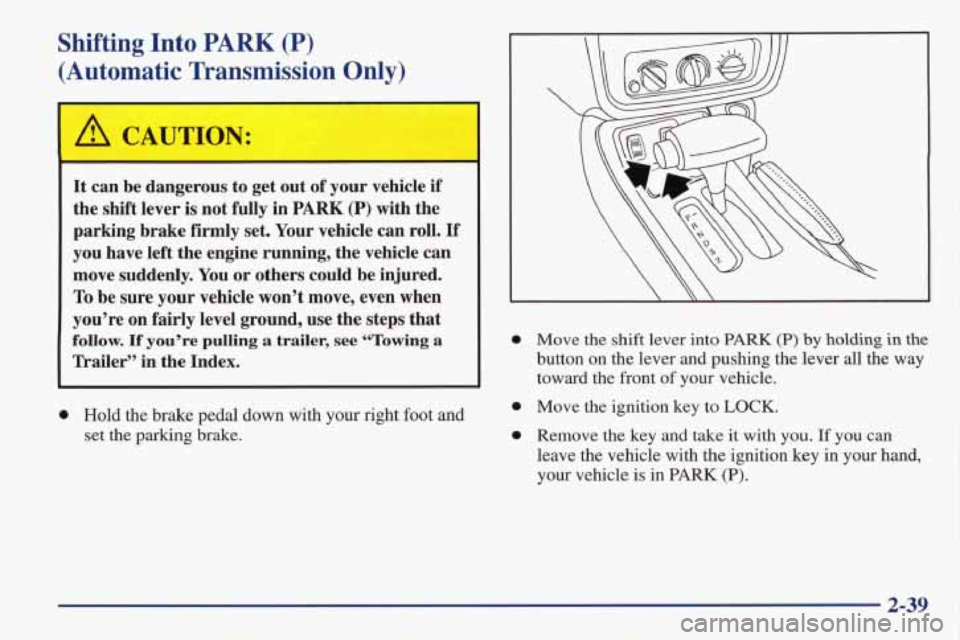
Shifting Into PARK (P)
:Automatic Transmission Only)
A CAUTION:
It can be dangerous to get out of your vehicle if
the shift lever is not fully in
PARK (P) with the
parking brake firmly set. Your vehicle can roll.
If
you have left the engine running, the vehicle can
move suddenly. You or others could be injured.
To be sure your vehicle won’t move, even when
you’re on fairly level ground, use the steps that
follow. If you’re pulling a trailer, see “Towing a
Trailer” in the Index.
0 Hold the brake pedal down with your right foot and
set the
parking brake.
0 Move the shift lever into PARK (P) by holding in the
button on the lever and pushing the lever all the way
toward the front of your vehicle.
0 Move the ignition key to LOCK.
0 Remove the key and take it with you. If you can
leave the vehicle with the ignition key in your hand,
your vehicle
is in PARK (P).
2-39
Page 96 of 406
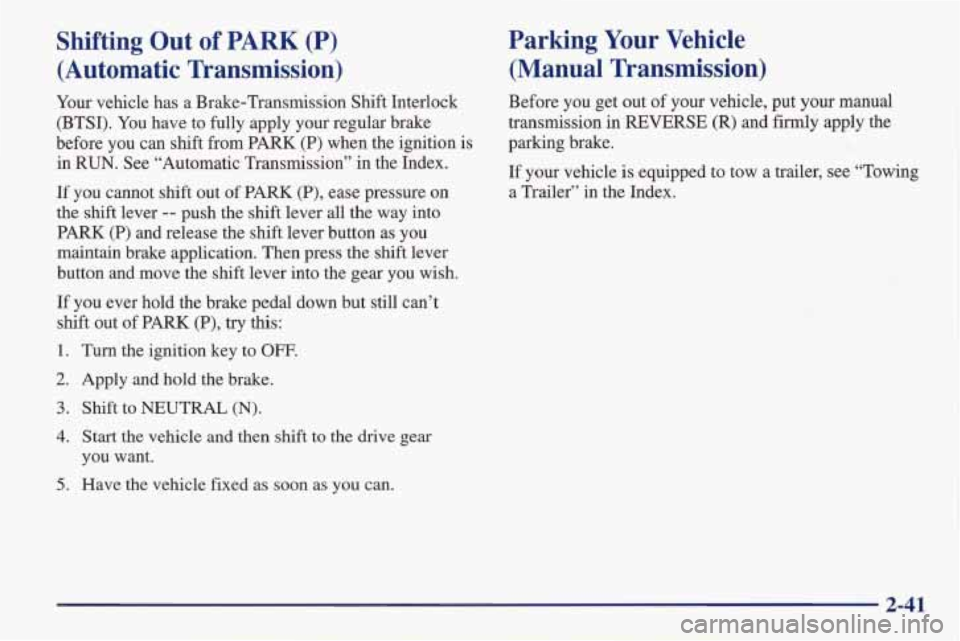
Shifting Out of PARK (P)
(Automatic Transmission) Parking Your Vehicle
(Manual Transmission)
Your
vehicle has a Brake-Transmission Shift Interlock Before you get out of your vehicle, put your manual
(BTSI). You have to fully apply your regular brake transmission in REVERSE \
(R) and firmly apply the
before you can shift from PARK (P) when the ignition is parking brake.
in RUN. See “Automatic Transmission” in the Index.
If
you cannot shift out of PARK (P), ease pressure on a Trailer” in the Index.
the shift lever
-- push the shift lever all the way into
PARK
(P) and release the shift lever button as you
maintain brake application. Then press the shift lever
button and move the shift lever into the gear you wish. If
your vehicle
is equipped to tow a trailer, see “Towing
If you ever hold the brake pedal down but still can’t
shift out of PARK (P), try this:
1. Turn the ignition key to OFF.
2. Apply and hold the brake.
3. Shift to NEUTRAL (N).
4. Start the vehicle and then shift to the drive gear
you want.
5. Have the vehicle fixed as soon as you can.
2-41
Page 98 of 406
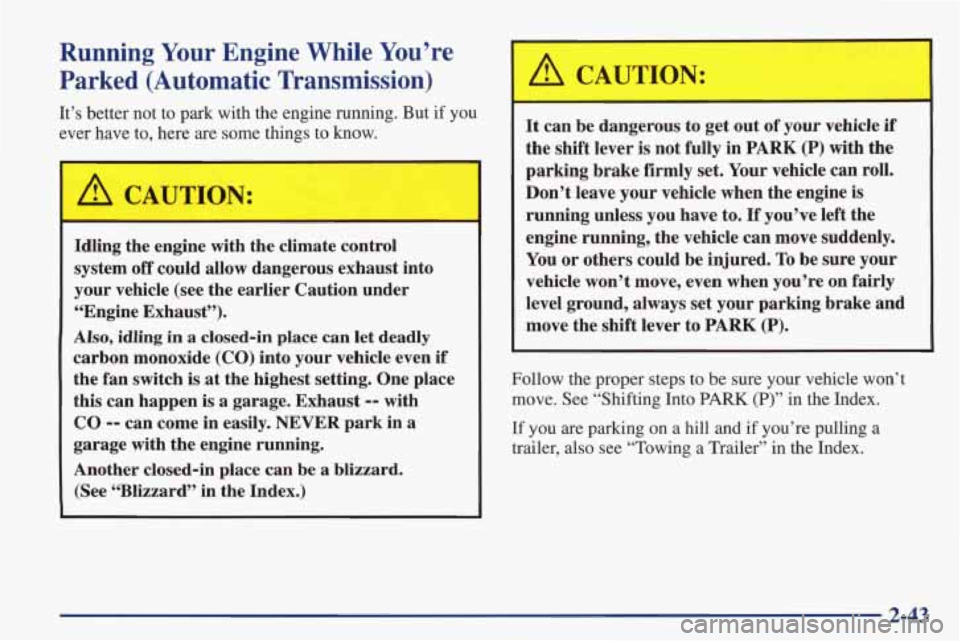
Running Your Engine While You’re
Parked (Automatic Transmission)
It’s better not to park with the engine running. But if you
ever have to, here are some things to know.
A CAUTION: I
Idling the engine with the climate control
system
off could allow dangerous exhaust into
your vehicle (see the earlier Caution under
“Engine Exhaust”).
Also, idling in a closed-in place can let deadly
carbon monoxide
(CO) into your vehicle even if
the fan switch is at the highest setting. One place
this can happen is
a garage. Exhaust -- with
CO
-- can come in easily. NEVER park in a
garage with the engine running.
Another closed-in place can be a blizzard.
(See “Blizzard” in the Index.)
A CAUTION:
It can be dangerous to get out of your vehicle if
the shift lever is not fully in PARK
(P) with the
parking brake firmly set. Your vehicle can roll.
Don’t leave your vehicle when the engine
is
running unless you have to. If you’ve left the
engine running, the vehicle can move suddenly.
You
or others could be injured. To be sure your
vehicle won’t move, even when you’re on fairly
level ground, always set your parking brake and
move the shift lever to PARK
(P).
Follow the proper steps to be sure your vehicle won’t
move. See “Shifting Into
PARK (P)” in the Index.
If you are parking on a hill and if you’re pulling a
trailer, also see “Towing a Trailer” in the Index.
2-43
Page 100 of 406
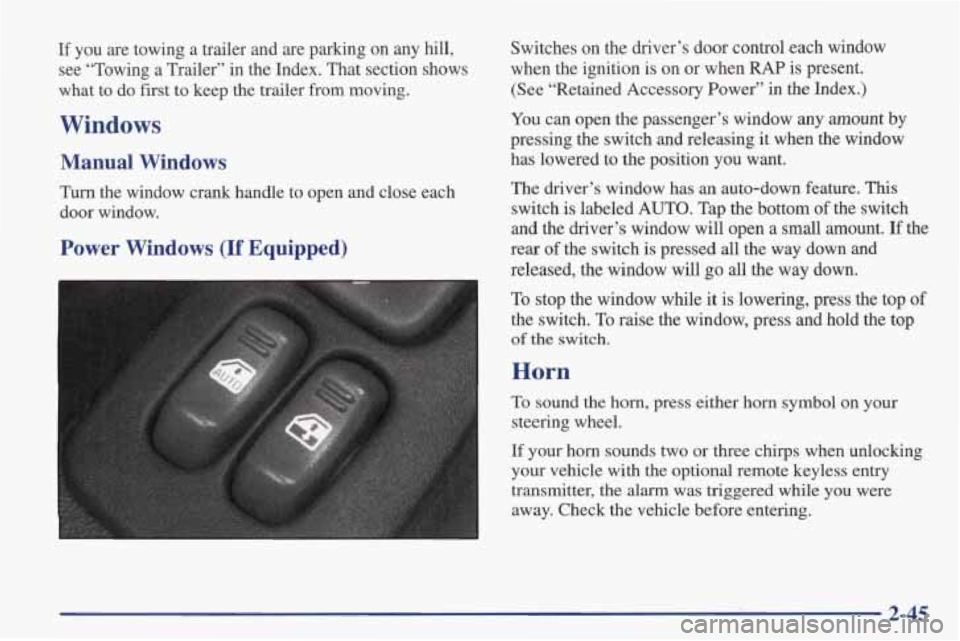
If you are towing a trailer and are parking on any hill,
see “Towing a Trailer” in the Index. That section shows
what to do first to keep the trailer from moving.
Windows
Manual Windows
Turn the window crank handle to open and close each
door window.
Power Windows (If Equipped)
Switches on the driver’s door control each window
when the ignition is on or when
RAP is present.
(See “Retained Accessory Power” in the Index.)
You can open the passenger’s window any amount by
pressing the switch and releasing it when the window
has lowered to the position you want.
The driver’s window has an auto-down feature. This
switch is labeled AUTO. Tap the bottom of the switch
and the driver’s window will open a small amount.
If the
rear of the switch is pressed all the way down and
released, the window will
go all the way down.
To stop the window while
it is lowering, press the top of
the switch.
To raise the window, press and hold the top
of the switch.
Horn
To sound the horn, press either horn symbol on your
steering wheel.
If your horn sounds two or three chirps when unlocking
your vehicle
with the optional remote keyless entry
transmitter, the
alarm was triggered while you were
away. Check the vehicle before entering.
2-45
Page 102 of 406

lhrn Signal and Lane Change Indicator
The turn signal has two upward (for right) and two
downward (for left) positions. These positions allow you
to signal a turn
or a lane change.
To signal a turn, move the lever all the way up or down.
When the turn is finished, the lever will retum automatically.
An arrow on the instrument
panel will flash in the
direction of the
turn or
1 lane change.
To signal a lane change, just raise or lower the lever
until
the arrow starts to flash. Hold it there until you
complete your lane change. The lever will return by
itself when you release it.
As you signal a turn or a lane change, if the arrows don’t
flash but just stay on,
a signal bulb may be burned out
and other drivers won’t see your
turn signal. If
a bulb is burned out, replace it
to help avoid an
accident. If the arrows don’t
go on at all when you
signal a turn, check the fuse (see “Fuses and Circuit
B&kers” in the Index).
Headlamp High/Low Beam
When the high-beams are
on, this light on the
instrument panel also will
be on.
To change the headlamps from low beam to high or
from high beam to low, pull the turn signal lever all the
way toward you. Then release it.
2-47
Page 114 of 406

Close-Out Panel
The close-out panel can be closed for hidden storage in
the rear area
of your vehicle. It can also help reduce
noise in the vehicle when placed in the upright position,
closing out the rear end area.
Removing the Close-Out Panel
1. Close the panel. If the close-out panel is not closed
and resting on the trim panel, it cannot be removed.
2. Pull the panel toward you to unsnap it. Then slide the
close-out panel along the groove in the trim panel.
Reverse the steps to install the panel.
2-59
Page 118 of 406

The door key unlocks the panels. The lock is over the
front door window. Turn the key counterclockwise to
unlock the panel.
1 I I
Then push on the release handle to unlatch the panel.
Lift the outer edge of the panel and pull it toward
you. Then carry the panel to the rear of the vehicle
for storage.
2-63
Page 121 of 406

After the inboard edge of the panel is in position under
the center roof rail, lower the outboard edge of the panel
into position, close the latch and lock the T-top.
NOTICE:
Do not attempt to install the panels by sliding
them horizontally toward the center roof rail.
Doing
so may cause the weatherstrips to be
aligned improperly, which may result
in leaks
and possible damage to the weatherstrips.
NOTICE:
High pressure car washes may cause water to
enter your vehicle. Never
spray water directly at
the roof panel joints. This will cause leaks.
2-66
Page 137 of 406
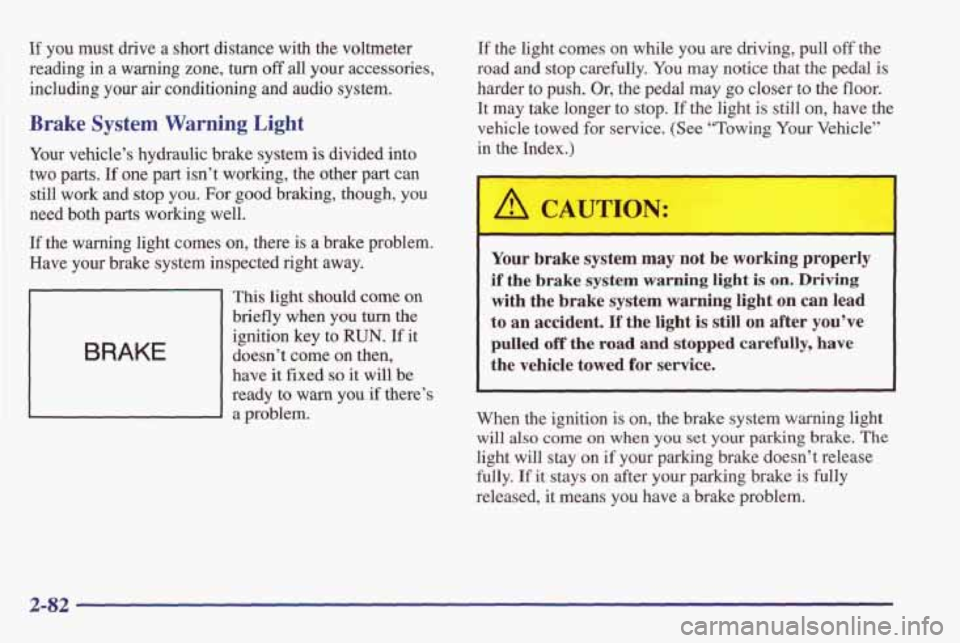
If you must drive a short distance with the voltmeter
reading
in a warning zone, turn off all your accessories,
including
your air conditioning and audio system.
Brake System Warning Light
Your vehicle’s hydraulic brake system is divided into
two parts. If one part isn’t working, the other part can
still work and stop you. For good braking, though, you
need
both parts working well.
If the warning light comes on, there is a brake problem.
Have your brake system inspected right away.
This light should come on
briefly when you
turn the
ignition key to
RUN. If it
doesn’t come
on then,
have it fixed
so it will be
ready to
warn you if there’s
a problem.
If the light comes on while you are driving, pull off the
road
and stop carefully. You may notice that the pedal is
harder to push.
Or, the pedal may go closer to the floor.
It may take longer to stop. If the light is still on, have the
vehicle towed for service. (See “Towing
Your Vehicle”
in the Index.)
I A CAUTION:
Your brake system may not be working properly
if the brake system warning light is on. Driving
with the brake system warning light on can lead
to an accident. If the light is still on after you’ve
pulled off the road and stopped carefully, have
the vehicle towed for service.
When the ignition is on, the brake system warning light
will also come on when you set your parking brake. The
light will stay on if your parking brake doesn’t release
fully.
If it stays on after your parking brake is fully
released,
it means you haye 3 bg,&e problem.
2-82
Page 142 of 406

If the Light Is Flashing If the Light Is On Steady
The following may prevent more serious damage to
your vehicle:
Reducing vehicle speed.
Avoiding hard accelerations.
0 Avoiding steep uphill grades.
If you are towing a trailer, reduce the amount of
cargo being hauled as soon as it is possible.
If the light stops flashing and remains on steady, see “If
the Light Is On Steady” following.
If the light continues to flash, when it is safe to do
so,
stop the vehicle. Find a safe place to park your vehicle.
Turn the key
off, wait at least 10 seconds and restart the
engine.
If the light remains on steady, see “If the Light
Is On Steady” following. If the light is still flashing,
follow the previous steps, and drive the vehicle to your
dealer or qualified service center for service.
You may be able to correct the emission system
malfunction by considering the following:
Did you recently put fuel into your vehicle?
If
so, reinstall the fuel cap, making sure to fully install
the cap. The diagnostic system can determine
if the fuel
cap has been left off
or improperly installed. A loose or
missing fuel cap will allow fuel to evaporate into the
atmosphere. A few driving trips with the cap properly
installed should turn the light off.
Did you just drive through
a deep puddle of water?
If
so, your electrical system may be wet. The condition
will usually be corrected when the electrical system
dries out. A few driving trips should turn the light off.
Are you low on fuel?
As your engine starts to run out of fuel, your engine may
not run as efficiently as designed since small amounts of
air
are sucked into the fuel line causing a misfire. The
system can detect this. Adding fuel should correct this
condition. Make sure to install the fuel cap properly. It
will take a few driving trips to turn the light
off.
2-87